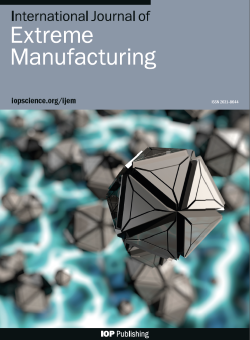
2019, 1(2) Column
International Journal of Extreme Manufacturing 第1卷 第2期
Precision is one of the most important aspects of manufacturing. High precision creates high quality, high performance, exchangeability, reliability, and added value for industrial products. Over the past decades, remarkable advances have been achieved in the area of high-precision manufacturing technologies, where the form accuracy approaches the nanometer level and surface roughness the atomic level. These extremely high precision manufacturing technologies enable the development of high-performance optical elements, semiconductor substrates, biomedical parts, and so on, thereby enhancing the ability of human beings to explore the macroand microscopic mysteries and potentialities of the natural world. In this paper, state-of-the-art high-precision material removal manufacturing technologies, especially ultraprecision cutting, grinding, deterministic form correction polishing, and supersmooth polishing, are reviewed and compared with insights into their principles, methodologies, and applications. The key issues in extreme precision manufacturing that should be considered for future R&D are discussed.
ultraprecision cutting grinding polishing supersmooth surface ultraprecision measurement extreme precision In order to meet the requirements of high reliability, long-lifetime and lightweight in a new generation of aerospace, aviation, high-speed train, and energy power equipment, integrated components are urgently needed to replace traditional multi-piece, welded components. The applications of integrated components involve in a series of large-size, complex-shaped, highperformance components made of difficult-to-deform materials, which present a huge challenge for forming ultra-large size integrated components. In this paper, the developments and perspectives of several extreme forming technologies are reviewed, including the sheet hydroforming of ultra-large curved components, dieless hydroforming of ellipsoidal shells, radial-axial ring rolling of rings, in situ manufacturing process of flanges, and local isothermal forging of titanium alloy components. The principle and processes for controlling deformation are briefly illustrated. The forming of typical ultra-large size integrated components and industrial applications are introduced, such as the high strength aluminum alloy, 3m in diameter, integrated tank dome first formed by using a sheet blank with a thickness the same as the final component, and a 16m diameter, integrated steel ring rolled by using a single billet. The trends for extreme forming of ultra-large size integrated components are discussed with a goal of providing ideas and fundamental guidance for the further development of new forming processes for extreme-size integrated components in the future.
ultra-large size integrated components extreme forming hydroforming radial-axial ring rolling isothermal forging Material embrittlement is often encountered in machining, heat treatment, hydrogen and lowtemperature conditions among which machining is strain-rate related. More strain-rate evoked embrittlement is expected in material loading processes, such as in high-speed machining and projectile penetration. In order to understand the fundamental mechanisms of the strain-rate evoked material embrittlement, this study is concerned with the material responses to loading at high strain-rates. It then explores the strain-rate evoked material embrittlement and fragmentation during high strain-rate loading processes and evaluates various empirical and physical models from different researchers for the assessment of the material embrittlement. The study proposes strain-rate sensitivity for the characterization of material embrittlement and the concept of the pseudo embrittlement for material responses to very high strain-rates. A discussion section is arranged to explore the underlying mechanisms of the strain-rate evoked material embrittlement and fragmentation based on dislocation kinetics.
embrittlement strain rate strain-rate sensitivity dislocation Halide perovskites have rapidly attracted considerable attention due to unprecedented properties not seen in traditional semiconductors. In addition to their optoelectronic merits, one advantage of perovskite materials is their solution processability, which opens the door to low-cost and high throughput solution coating strategies for the commercialization of perovskite solar cells (PSCs). Here we review perovskite film fabrication by meniscus coating—a simple and readily scalable manufacturing technique, including blade coating and slot-die coating.We outline the fundamental fluid mechanisms of meniscus coating, discuss drying and crystallization of perovskite in the coating process, and provide an overview of recent progress in meniscus-coated PSCs.
meniscus coating large area perovskite thin films Three-dimensional (3D) electrically conductive micro/nanostructures are now a key component in a broad range of research and industry fields. In this work, a novel method is developed to realize metallic 3D micro/nanostructures with silver-thiol-acrylate composites via two-photon polymerization followed by femtosecond laser nanojoining. Complex 3D micro/nanoscale conductive structures have been successfully fabricated with ~200 nm resolution. The loading of silver nanowires (AgNWs) and joining of junctions successfully enhance the electrical conductivity of the composites from insulating to 92.9 Sm-1 at room temperature. Moreover, for the first time, a reversible switching to a higher conductivity is observed, up to ~105Sm-1 at 523 K. The temperature-dependent conductivity of the composite is analyzed following the variable range hopping and thermal activation models. The nanomaterial assembly and joining method demonstrated in this study pave a way towards a wide range of device applications, including 3D electronics, sensors, memristors, micro/nanoelectromechanical systems, and biomedical devices, etc.
precise assembly joining silver nanowires nanofabrication three dimensional 

